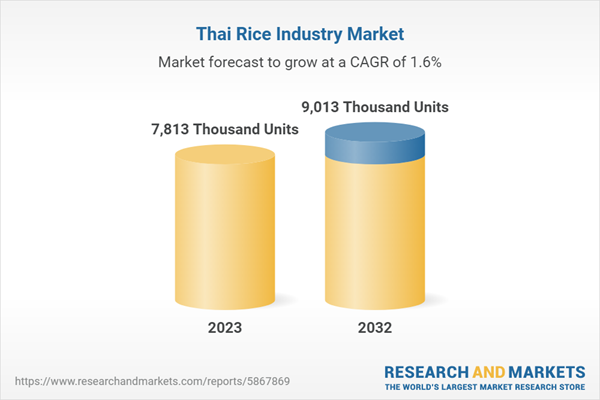In 2022, Thailand exported 7.69 million tons of rice, exceeding the Ministry of Commerce's target of 7.5 million tons. Exports rose 25.77 percent from 6.12 million tons in 2021, while the value in Thai baht terms increased 28.48 percent to 138.45 billion baht ($4.02 billion). 2022 saw Thailand become the world's second-largest rice exporter after India, which exported 21.9 million tons. Iraq is the largest importer of Thai rice, buying 1.6 million tons last year, up 458 percent from a year earlier. South Africa came in second, importing 775,000 tons (down 2.26 percent), followed by China at 750,000 tons (up 18.8 percent), the United States at 650,000 tons (up 13.2 percent) and Benin at 321,000 tons (down 15.3 percent). According to the analysis, in 2022, Thailand's total rice production of nearly 18.86 million tons meets demand for domestic consumption, processing, use in poultry and livestock feed, and export.
In terms of price, the average price of Thai rice exports increased by 2.16 percent year-on-year to $521.88 per ton in 2022. The price of broken 5% white rice remained high on the world market, rising to US$523 per ton on January 18 from US$465 per ton in mid-December.
The baht weakens again in 2023. The outlook for the Thai baht is critical for the country's rice exports this year. If the baht continues to weaken, Thai rice exports will be competitive in the world market.
A weaker baht, rising domestic consumption stocks in India and Vietnam, and growing demand from the Middle East are key factors helping to drive Thai rice exports. The analyst expects the exports volume of Thailand's rice to reach 9.01 million tons in 2032, growing at a compound annual growth rate (CAGR) of 1.6 percent over the 2023-2032 period.
Topics covered:
- Overview of the Thai rice industry
- Economic and policy environment of the Thai rice industry
- What is the impact of COVID-19 on the Thai rice industry?
- Market Size of Thai Rice Industry, 2023-2032
- Analysis of major Thai rice industry players
- Key Drivers and Market Opportunities in Thailand Rice Industry
- What are the key drivers, challenges and opportunities for the Thai Rice industry during the forecast period 2023-2032?
- Which are the key players in the Thailand Rice Industry market and what are their competitive advantages?
- What is the expected revenue of Thailand Rice Industry market during the forecast period 2023-2032?
- What strategies have been adopted by the key players in the market to increase their market share in the industry?
- Which segment of the Thailand Rice Industry market is expected to dominate the market by 2032?
- What are the major unfavorable factors facing the Thai rice industry?
Table of Contents
Companies Mentioned
- Group of Asia Golden Rice Co.Ltd.
- Group of Capital Rice Co. Ltd.
- Group of C.P. Intertrade Co. Ltd.
- Golden Granary Co. Ltd.
- Group of Thai Hua
- Aden International Co. Ltd.
- Ake Rice Mill Co. Ltd.
- Asia Golden Rice Co. Ltd.
- Asia Grains Syndicate Co. Ltd.
- Asia Intertrade Rice Export Co. Ltd.
Methodology
Background research defines the range of products and industries, which proposes the key points of the research. Proper classification will help clients understand the industry and products in the report.
Secondhand material research is a necessary way to push the project into fast progress. The analyst always chooses the data source carefully. Most secondhand data they quote is sourced from an authority in a specific industry or public data source from governments, industrial associations, etc. For some new or niche fields, they also "double-check" data sources and logics before they show them to clients.
Primary research is the key to solve questions, which largely influence the research outputs. The analyst may use methods like mathematics, logical reasoning, scenario thinking, to confirm key data and make the data credible.
The data model is an important analysis method. Calculating through data models with different factors weights can guarantee the outputs objective.
The analyst optimizes the following methods and steps in executing research projects and also forms many special information gathering and processing methods.
1. Analyze the life cycle of the industry to understand the development phase and space.
2. Grasp the key indexes evaluating the market to position clients in the market and formulate development plans
3. Economic, political, social and cultural factors
4. Competitors like a mirror that reflects the overall market and also market differences.
5. Inside and outside the industry, upstream and downstream of the industry chain, show inner competitions
6. Proper estimation of the future is good guidance for strategic planning.

LOADING...
Table Information
| Report Attribute | Details |
|---|---|
| No. of Pages | 60 |
| Published | August 2023 |
| Forecast Period | 2023 - 2032 |
| Estimated Market Value in 2023 | 7813 Thousand Units |
| Forecasted Market Value by 2032 | 9013 Thousand Units |
| Compound Annual Growth Rate | 1.6% |
| Regions Covered | Thailand |
| No. of Companies Mentioned | 10 |









